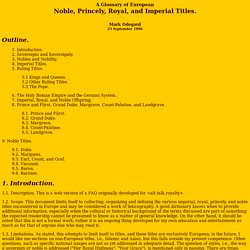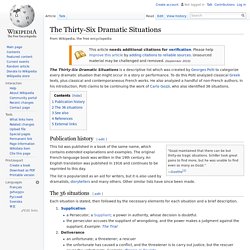

Wondermark.com. A Glossary of European Noble, Princely, Royal and Imperial Titles. Outline. 1.

Introduction. 2. Sovereigns and Sovereignty. 3. Nobles and Nobility. 4. Imperial Titles. 5. 5.1 Kings and Queens. 5.2 Other Ruling Titles. 5.3 The Pope. What is the royal Hierarchy? King/Queen Regnant Queen/Prince Consort(spouses to the sovereign) Prince/Princess who are the heir apparent or heir presumptive to the throne Prince/Princess All of the above may bear a ROYAL version or versions of these peerage titles: Duke/Duchess,Marquess/Marchioness, Earl/Countess, Viscount/Viscountess,Baron/Baroness For example,Charles,Prince of Wales is also Duke of Cornwall, Duke of Rothesay, Earl of Carrick and Baron Renfrew, Lord of the Isles, and Prince and Great Steward of Scotland.

Royal Dukes,et cetera,are all higher in precedence than the non-royal peerage. Non-royal peerage members are: Duke/Duchess Marquess/Marchioness Earl/Countess Viscount/Viscountess Baron/Baroness Non-peerage: Baronet/Baronetess Knight/Dame These are all of the UK titles.There is a site that lists and provides histories of all European Titles at that gives a little history as well. Royal and noble ranks. Traditional rank amongst European royalty, peers, and nobility is rooted in Late Antiquity and the Middle Ages.

Although they vary over time and between geographic regions (for example, one region's prince might be equal to another's grand duke), the following is a reasonably comprehensive list that provides information on both general ranks and specific differences. Ranks and titles[edit] Sovereign[edit] Main articles: Monarch and Sovereign Common titles for European and Near Eastern monarchs Note that many titles listed may also be used by lesser nobles – non-sovereigns – depending on the historical period and state.
Imperial titles High royal titles King of Kings mostly used in Christian contexts to denote Jesus Christ or the Christian Roman emperors of the Late Empire and Byzantine periods. 10 Classic Literature Terms That Are No Longer Used (For the Most Part) Reading a book from the 18th or 19th century is kind of like reading a handwritten, entirely cursive note from your grandmother in that, unless you have experience with such material, you will only understand 60% of the language used.

Considering that it’s physically impossible for me to make it through any old book without an online dictionary open on my computer screen, I think it’s safe to say that there are some words used in classic literature that are not entirely common or have fallen out of use completely. For your convenience, I’ve compiled a list of some of the more obscure classic lit terms (or ones that are used less frequently today) because I feel selfish enjoying them all by myself: Mackintosh/Macintosh (n.): waterproof raincoat Can you believe Mac computers were invented in 1824?
I guess Steve Jobs was older than we all thought… I’m kidding, of course. Pusillanimity (n.): cowardliness Belly Timber (n.): food Wiseacres (n.): a know-it-all Habiliments (n.): clothing.
aDAEAeB_700b.jpg (JPEG Image, 700 × 509 pixels) Generators/processors. Weapons/Fighting. Sword. The Thirty-Six Dramatic Situations. The Thirty-Six Dramatic Situations is a descriptive list which was created by Georges Polti to categorize every dramatic situation that might occur in a story or performance.

To do this Polti analyzed classical Greek texts, plus classical and contemporaneous French works. He also analyzed a handful of non-French authors. In his introduction, Polti claims to be continuing the work of Carlo Gozzi, who also identified 36 situations. Publication history[edit] “Gozzi maintained that there can be but thirty-six tragic situations. This list was published in a book of the same name, which contains extended explanations and examples.
The list is popularized as an aid for writers, but it is also used by dramatists, storytellers and many others. The 36 situations[edit] Each situation is stated, then followed by the necessary elements for each situation and a brief description. See also[edit] References[edit] External links[edit] Victorian &Steampunk Name Generator.